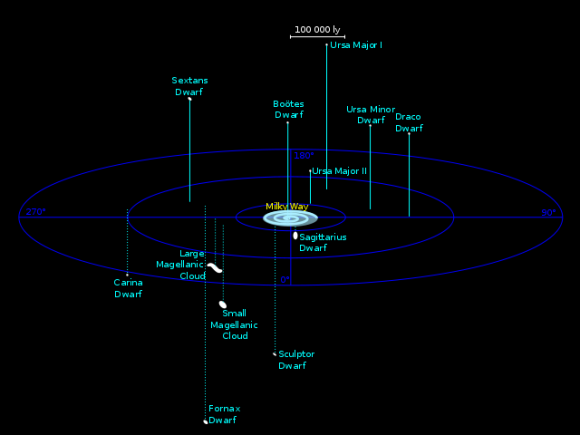
Our Milky Way galaxy doesn’t travel alone through space. Instead, it has a couple of dozen possible satellites, with the irregular Large and Small Magellanic Clouds – visible from Earth’s Southern Hemisphere – being the best known. You’ll find a list of Milky Way satellite galaxies here. It’s possible not all are true satellites; some might simply be moving nearby in space. A couple of dozen satellite candidates may seem like a lot, but it’s not as many as scientists believe the Milky Way should have, based on computer simulations. Various astronomers have tried to explain the lack of Milky Way satellites, and European scientists this week added to the conversation about why our galaxy’s satellites are so few.
Their solution throws doubt on a generally accepted theory of cold dark matter. It’s this invisible and mysterious substance that lets scientists predict more galaxy formation around the Milky Way than is actually seen.
The European scientists – cosmologists and particle physicists, working together – are at Durham University in the U.K. and LAPTh College & University in France. Writing in the journal Monthly Notices of the Royal Astronomical Society, these scientists suggest that dark matter particles might have interacted with photons and neutrinos in the young universe. If so, the dark matter would have “scattered,” and this scattering would have led to fewer Milky Way satellites.
To understand it, you have to go back to the way dark matter helps form galactic structures. Scientists believe clumps or halos of dark matter – thought to have emerged from the early universe – trapped the intergalactic gas needed to form stars and galaxies.
Scattering the dark matter particles, therefore, would wipe out the structures that can trap gas. If this actually happened – if the interaction of dark matter particles with photons and neutrinos occurred in the way these scientists suggest, in the early universe – it means some galaxies would have been prevented from forming. Thus there would be fewer satellites for our Milky Way galaxy, as is actually observed.

Lead author Dr. Celine Boehm, in the Institute for Particle Physics Phenomenology at Durham University, said:
We don’t know how strong these interactions should be, so this is where our simulations come in.
By tuning the strength of the scattering of particles, we change the number of small galaxies, which lets us learn more about the physics of dark matter and how it might interact with other particles in the universe.
This is an example of how a cosmological measurement, in this case the number of galaxies orbiting the Milky Way, is affected by the microscopic scales of particle physics.
The researchers say their work could provide a novel technique to probe interactions between other particles and cold dark matter.
Co-author Professor Carlton Baugh said:
Astronomers have long since reached the conclusion that most of the matter in the universe consists of elementary particles known as dark matter. This model can explain how most of the universe looks, except in our own backyard where it fails miserably. The model predicts that there should be many more small satellite galaxies around our Milky Way than we can observe.
However, by using computer simulations to allow the dark matter to become a little more interactive with the rest of the material in the universe, such as photons, we can give our cosmic neighborhood a makeover and we see a remarkable reduction in the number of galaxies around us compared with what we originally thought.
Bottom line: European cosmologists and particle physicists, working together, have a new theory of how cold dark matter interacts with elementary particles – such as photons and neutrinos – in the early universe. Their work shows that the particles act to “scatter” the dark matter. If this model is correct, then it accounts for fact that our own Milky Way galaxy has fewer satellites than scientists expect it to have. If it’s correct, then it must have far-reaching implications about the formation of structures throughout our universe.
Via the Royal Astronomical Society












